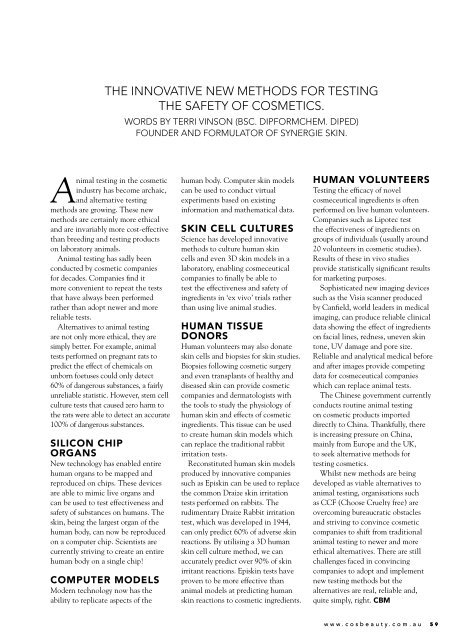CosBeauty Magazine #74
CosBeauty Magazine is the authoritative, number-one magazine dedicated to lifestyle, health and beauty. Features on the latest global and local beauty trends, new product and technology updates, and articles on the future of wellness, health and appearance medicine with expert interviews by leaders in the health and beauty space. CBM is the go-to guide for anyone looking to enhance their life – whether it’s cosmetic surgery, cult-status beauty buys or the latest way to detox your mind, body and soul. It’s the fresh way to look at beauty and appearance medicine.
CosBeauty Magazine is the authoritative, number-one magazine dedicated to lifestyle, health and beauty.
Features on the latest global and local beauty trends, new product and technology updates, and articles on the future of wellness, health and appearance medicine with expert interviews by leaders in
the health and beauty space.
CBM is the go-to guide for anyone looking to enhance their life – whether it’s cosmetic surgery, cult-status beauty buys or the latest way to detox your mind, body and soul. It’s the fresh way to look at beauty and appearance medicine.
Create successful ePaper yourself
Turn your PDF publications into a flip-book with our unique Google optimized e-Paper software.
the Innovative new methods for testing<br />
the safety of cosmetics.<br />
Words by Terri Vinson (BSc. DipFormChem. DipEd)<br />
Founder and Formulator of Synergie Skin.<br />
Animal testing in the cosmetic<br />
industry has become archaic,<br />
and alternative testing<br />
methods are growing. These new<br />
methods are certainly more ethical<br />
and are invariably more cost-effective<br />
than breeding and testing products<br />
on laboratory animals.<br />
Animal testing has sadly been<br />
conducted by cosmetic companies<br />
for decades. Companies find it<br />
more convenient to repeat the tests<br />
that have always been performed<br />
rather than adopt newer and more<br />
reliable tests.<br />
Alternatives to animal testing<br />
are not only more ethical, they are<br />
simply better. For example, animal<br />
tests performed on pregnant rats to<br />
predict the effect of chemicals on<br />
unborn foetuses could only detect<br />
60% of dangerous substances, a fairly<br />
unreliable statistic. However, stem cell<br />
culture tests that caused zero harm to<br />
the rats were able to detect an accurate<br />
100% of dangerous substances.<br />
Silicon chip<br />
organs<br />
New technology has enabled entire<br />
human organs to be mapped and<br />
reproduced on chips. These devices<br />
are able to mimic live organs and<br />
can be used to test effectiveness and<br />
safety of substances on humans. The<br />
skin, being the largest organ of the<br />
human body, can now be reproduced<br />
on a computer chip. Scientists are<br />
currently striving to create an entire<br />
human body on a single chip!<br />
Computer models<br />
Modern technology now has the<br />
ability to replicate aspects of the<br />
human body. Computer skin models<br />
can be used to conduct virtual<br />
experiments based on existing<br />
information and mathematical data.<br />
Skin cell cultures<br />
Science has developed innovative<br />
methods to culture human skin<br />
cells and even 3D skin models in a<br />
laboratory, enabling cosmeceutical<br />
companies to finally be able to<br />
test the effectiveness and safety of<br />
ingredients in ‘ex vivo’ trials rather<br />
than using live animal studies.<br />
Human tissue<br />
donors<br />
Human volunteers may also donate<br />
skin cells and biopsies for skin studies.<br />
Biopsies following cosmetic surgery<br />
and even transplants of healthy and<br />
diseased skin can provide cosmetic<br />
companies and dermatologists with<br />
the tools to study the physiology of<br />
human skin and effects of cosmetic<br />
ingredients. This tissue can be used<br />
to create human skin models which<br />
can replace the traditional rabbit<br />
irritation tests.<br />
Reconstituted human skin models<br />
produced by innovative companies<br />
such as Episkin can be used to replace<br />
the common Draize skin irritation<br />
tests performed on rabbits. The<br />
rudimentary Draize Rabbit irritation<br />
test, which was developed in 1944,<br />
can only predict 60% of adverse skin<br />
reactions. By utilising a 3D human<br />
skin cell culture method, we can<br />
accurately predict over 90% of skin<br />
irritant reactions. Episkin tests have<br />
proven to be more effective than<br />
animal models at predicting human<br />
skin reactions to cosmetic ingredients.<br />
human volunteers<br />
Testing the efficacy of novel<br />
cosmeceutical ingredients is often<br />
performed on live human volunteers.<br />
Companies such as Lipotec test<br />
the effectiveness of ingredients on<br />
groups of individuals (usually around<br />
20 volunteers in cosmetic studies).<br />
Results of these in vivo studies<br />
provide statistically significant results<br />
for marketing purposes.<br />
Sophisticated new imaging devices<br />
such as the Visia scanner produced<br />
by Canfield, world leaders in medical<br />
imaging, can produce reliable clinical<br />
data showing the effect of ingredients<br />
on facial lines, redness, uneven skin<br />
tone, UV damage and pore size.<br />
Reliable and analytical medical before<br />
and after images provide competing<br />
data for cosmeceutical companies<br />
which can replace animal tests.<br />
The Chinese government currently<br />
conducts routine animal testing<br />
on cosmetic products imported<br />
directly to China. Thankfully, there<br />
is increasing pressure on China,<br />
mainly from Europe and the UK,<br />
to seek alternative methods for<br />
testing cosmetics.<br />
Whilst new methods are being<br />
developed as viable alternatives to<br />
animal testing, organisations such<br />
as CCF (Choose Cruelty free) are<br />
overcoming bureaucratic obstacles<br />
and striving to convince cosmetic<br />
companies to shift from traditional<br />
animal testing to newer and more<br />
ethical alternatives. There are still<br />
challenges faced in convincing<br />
companies to adopt and implement<br />
new testing methods but the<br />
alternatives are real, reliable and,<br />
quite simply, right. CBM<br />
www.cosbeauty.com.au 59


















